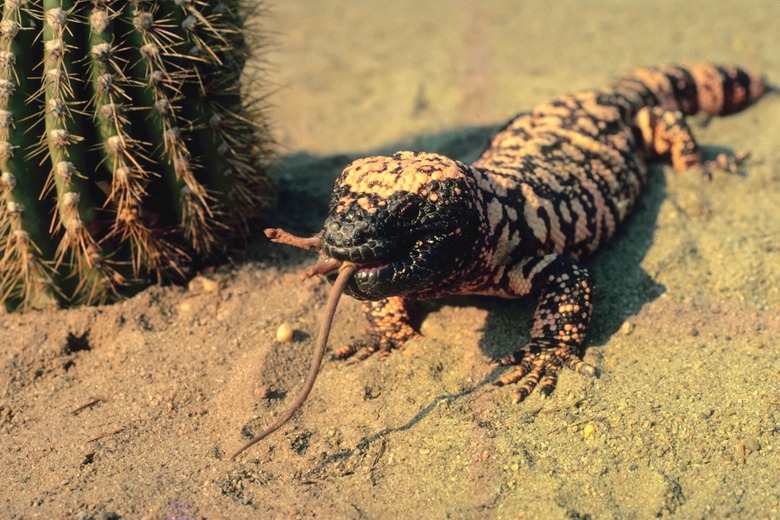What Kind Of Wildlife Live In The Deserts?
Deserts — regions that receive less than 10 inches of rain a year — cover approximately a quarter of the Earth's land surface, mostly in Africa, Asia, Australia and North America.
Most desert organisms are small mammals and reptiles, some of which dig underground burrows to escape from the scorching desert heat. Few large desert fauna can survive in the desert; those that do have special adaptations that allow them to withstand their inhospitable environment.
Desert Wildlife: Mammals
Desert Wildlife: Mammals
Large mammals adapted to desert life include hoofed animals like the addax antelope and the Bactrian camel of Africa's Sahara Desert and Asia's Gobi Desert, respectively.
Both have wide, flat hooves that allow them to walk on sand without sinking. Bactrian camels, which have two humps, can close their nostrils to keep sand out. Small mammals are more common in deserts. The Sahara alone is home to around 40 species of rodents, including the jerboa.
Other mammals include the Mohave ground squirrel, found in the desert of the same name in California, and the elusive marsupial mole of the Central Australian deserts.
Reptiles Living in Desert Habitats
Reptiles Living in Desert Habitats
The desert-dwelling reptile population includes desert tortoises and desert iguanas, found in the Mohave and Sonora deserts. Both species burrow, though the desert iguana is more resistant to heat and is active during the warmest hours.
Desert tortoises spend most of their time underground and hibernate in the winter to reduce water loss. Their bodies can also draw water stored in their bladders. The Mohave and Sonora deserts also harbor the Gila monster, a venomous lizard known to burrow.
Gila monsters are nocturnal during the summer and can live off fat stored in their tails during cold winters. Ten species of horned lizards also occur in the Sonora Desert, as do desert grassland whiptail lizards. All of the latter are female; offspring are clones of the mother.
Some snakes also live in desert habitats, including the rattlesnakes of North America and the horned viper of the Sahara.
Birds of the Desert
Birds of the Desert
Several species of owl live in deserts, including the elf owl of the Sonora Desert, which nests in cavities carved into saguaro cacti by another bird, the Gila woodpecker.
The aptly named burrowing owl, found in the deserts of North and South America, occupies burrows dug out by squirrels and other small mammals. One of the most iconic desert birds is the roadrunner, an omnivorous bird found in the Sonora Desert. It prefers running to flying and can outrun a person.
The deserts of Africa are home to the ostrich, the world's largest bird. Ostriches are also speedy omnivores, but unlike the roadrunner, they cannot fly.
Desert Amphibians
Desert Amphibians
Amphibians begin their lives as an aquatic larva. The number of amphibians that can survive in the desert is therefore limited to a few highly adapted species, such as the desert spadefoot, the casque-headed tree frog and the Sonora desert toad of the American Southwest, which spend most of the year in burrows.
As its name suggests, the desert spadefoot has hardened areas on its hind legs that enable it to dig. These desert animals lay their eggs in pools of water created by sporadic summer showers.
Insects and Arachnids That Live in Deserts
Insects and Arachnids That Live in Deserts
Species of spiders, scorpions, bees, centipedes, beetles, weevils, moths, dragonflies, ants and crickets all live in desert environments. Many desert insects such as the desert scorpion of Australia burrow to avoid the harsh environmental conditions.
While most ants use pheromones to make their way back to the nest, the Sahara desert ant requires different methods due to fast evaporation in the heat. It is thought that they use landmarks to make their way back to the nest visually.
References
- San Diego Zoo Animal Bytes: Desert
- Defenders of Wildlife: Basic Facts about Deserts
- Defenders of Wildlife: Desert Tortoise
- San Diego Zoo Animal Bytes: Gila Monster
- Defenders of Wildlife: Mohave Ground Squirrel
- National Audubon Society: Elf Owl
- Defenders of Wildlife: Burrowing Owl
- Audubon Guides: Greater Roadrunner
- Arizona-Sonora Desert Museum: Desert Iguana
- National Geographic: Bactrian Camels
- Encyclopaedia Britannica: Sahara Desert Ant
- Australian Museum: Desert Scorpion
- In the Desert: Insects
Cite This Article
MLA
Alonso, Nathalie. "What Kind Of Wildlife Live In The Deserts?" sciencing.com, https://www.sciencing.com/kind-wildlife-live-deserts-3443/. 11 June 2019.
APA
Alonso, Nathalie. (2019, June 11). What Kind Of Wildlife Live In The Deserts?. sciencing.com. Retrieved from https://www.sciencing.com/kind-wildlife-live-deserts-3443/
Chicago
Alonso, Nathalie. What Kind Of Wildlife Live In The Deserts? last modified March 24, 2022. https://www.sciencing.com/kind-wildlife-live-deserts-3443/
